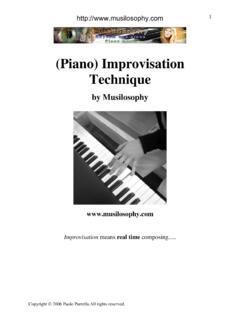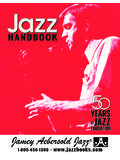Transcription of ASIC MUSIC THEORY - Corcoran High School Panther Bands
1 BASIC MUSIC THEORY . HOW TO READ, WRITE, AND UNDERSTAND. WRITTEN MUSIC . Sol-Ut Press Basic MUSIC THEORY : How to Read, Write, and Understand Written MUSIC Published by Sol-Ut Press A MUSIC Education Business Copyright 2001 Questions, Ink. All rights reserved. No part of this book , including interior design, cover design, and icons, may be reproduced or transmitted in any form, by any means (electronic, photocopying, recording, or otherwise) without the prior written permission of the publisher. Questions, Ink and the logo are trademarks of Sol-Ut Press. send E-mail regarding this book to LCCN: 2001086279. ISBN: 0-9707512-9-X. For general information about this book or Sol-Ut Press, visit our web site at or Publisher's Cataloging-in-Publication (Provided by Quality Books, Inc.). Harnum, Jonathan. Basic MUSIC THEORY : how to read, write, and understand written MUSIC / Jonathan Harnum.
2 -- 1st ed. p. cm. Includes index. LCCN 2001086279. ISBN 0-9707512-9-X. 1. MUSIC THEORY . 2. Conducting. 3. Musical notation. I. Title. 2001 781. QBI01-700378. What's New in Basic MUSIC THEORY 2nd ed. The best-seller has been completely revised and expanded! New Chapter on the Guitar Fingerboard Change in sequence of material. Rhythm before pitch. Larger format ( x 11) for easier reading Updated web references More scales included Basic MUSIC THEORY More Practical Use exercises 2nd edition More blank staves to practice on Jonathan Harnum Revised Chapter and Part Reviews Links to helpful information on Fully hyperlinked TOC, Index, cross-references, and web addresses $ Click to order Read what folks have to say about the MUSIC THEORY book versatile enough to be used by middle schools, universities, and adults! Fun and engaging. A real winner! Terrie Lyons, PhD, Jonathan Harnum has taken an overly complicated subject matter and made it learnable for anyone.
3 And I do mean anyone! Harnum de-cryptifies all that is involved with MUSIC THEORY for the non-musician. But this book is not just for the non-musician. I have been a student of MUSIC for more than 13 years and a teacher for 3 and I found myself finding new and interesting (and humorous) facts about MUSIC THEORY . This book can teach anyone MUSIC THEORY and keep a smile on their face the entire time.. Robin Gibelhausen, MUSIC teacher, Illinois Basic MUSIC THEORY by Jonathan Harnum is an excellent book for people of all levels. I have played various instruments over 24 years and because of Harnum's matter of fact, conversational tone, this book has lent more to my understanding of basic MUSIC THEORY than all my private instructors combined. Solstice 1221, Anon. reader in LA. I appreciate the clever and humorous ways that you introduce many of the concepts. The illustrations and pictures are very helpful.
4 Can't wait to get to the bookstore to get a copy for myself.. Dave Larsen, elementary teacher, Hawarden, IA. Basic MUSIC THEORY is an ideal and highly recommended text for anyone of any background wanting to become proficient in the reading, composing, and performance of written and notated MUSIC .. Midwest book Review (5 stars, highest rating). This is a book that covers lots of ground without ever appearing "difficult.". It is written in a breezy, conversational manner, so one "talk" naturally drifts into the next.. KLIATT Library Review Service EVEN LISTENING TO MUSIC IS PROVEN TO MAKE. YOU SMARTER! NO JOKE. One important center of this research has been the University of California at Irvine, where Drs. Gordon Shaw and Fran Rauscher have found that active MUSIC making improves children's math skills. Shaw is a physicist who found that the inner working of the human brain operates in patterns that resemble musical structures, and he suspects that MUSIC may be the key to understanding intelligence.
5 Other research supports similar conclusions: at McGill University in Canada, researchers found that kids who take piano lessons showed improved general and spatial cognitive development, and studies at a Miami Veterans Administration hospital indicate that MUSIC making may improve the brain's natural production of regulatory hormones like melatonin. And most amazingly, an experiment by Rauscher showed that listening to the first ten minutes of the Mozart Concerto for Two Pianos in D Major (K. 448) improved the listeners' spatial-temporal reasoning! In the days of the New England singing-schools, people believed in teaching and learning MUSIC because it was good for the soul. We've learned a lot since then. If MUSIC really can make a person better at math, science and engineering, and if just listening to MUSIC can make you smarter, why wouldn't anyone want to benefit from MUSIC ?
6 As we begin a new century, there is proof about the power of MUSIC education. And it's still good for your soul. For more information about MUSIC and the brain visit: JUST AS THERE CAN BE NO MUSIC . WITHOUT LEARNING, NO EDUCATION IS. complete WITHOUT MUSIC . THIS book IS DEDICATED. TO ALL MY TEACHERS, AND. TO MY STUDENTS, WHO ARE. ALSO MY TEACHERS. THANK YOU. Click on a subject to jump to its corresponding page Basic MUSIC THEORY Table of Contents 0 The Chapter Everyone Skips .. 1. Welcome to Basic MUSIC THEORY ! .. 2. Why Basic MUSIC THEORY ? .. 3. What's Inside .. 3. The Icons.. 5. Basic MUSIC THEORY : Overview .. 6. How to Use the Special Features .. 9. Moving On .. 9. PART ONE: START ME UP. 1 An Ultra-brief History of Musical Notation .. 13. Hear, There, Everywhere .. 14. MUSIC Performed .. 15. The Future .. 20. Moving On .. 21. 2 Lines, Lines, Everywhere There's Lines.
7 23. The Staff.. 24. Moving On .. 25. Chapter 2 Study Guide .. 25. 3 More Lines.. 27. No Holds Barred .. 28. What? More Lines? .. 28. Moving On .. 29. Chapter 3 Study Guide .. 30. 4 The Wind-up and the Pitch .. 31. Spaced Out and Lined Up .. 32. The High and the Lowly .. 33. Moving On .. 34. Chapter 4 Study Guide .. 34. Home, Home on the Ranges .. 36. 5 A Note by Any Other Name Would Sound as Sweet .. 37. What's in a Name? .. 38. Moving On .. 39. Basic MUSIC THEORY vii Chapter 5 Study Guide .. 40. Part I Review .. 41. Whew! You Made It.. 41. The Review .. 41. Moving On .. 44. PART TWO: CLEF NOTES. 6 Going Over the Clef .. 47. What's a Clef? .. 48. The Clefs .. 49. Moving On .. 52. Chapter 6 Study Guide .. 52. 7 No Trouble with Treble .. 55. Golly G .. 56. Moving On .. 58. Chapter 7 Study Guide .. 58. 8 The Bass of the Clef .. 61. This Clef is Not a Fish! .. 62.
8 Nmore Mnemonics .. 63. Moving On .. 64. Chapter 8 Study Guide .. 65. 9 To Fathom the Rhythm Clef .. 67. No Letters With this Staf..f 68. Why No Note Names? .. 68. The One-Line Staff with Rhythm Clef .. 68. Instruments, not Pitches .. 69. The 5-Line Staff with Rhythm Clef .. 69. Moving On .. 71. Chapter 9 Review .. 71. Part II Review .. 73. Whew! You Made It.. 73. The Review .. 73. Moving On .. 77. viii INTERLUDE: COMING TO TERMS. 10 Musical Terms .. 79. Musical Terms are Directions .. 80. Tempo .. 80. Dynamics.. 81. Articulations .. 82. General Musical Terms.. 84. Pete and Repeat .. 85. Moving On .. 87. PART THREE: YOU GOT RHYTHM. 11 Where's the Beat? .. 91. The Beat Goes On .. 92. The Notes .. 92. Note Anatomy 101 .. 93. The Stem .. 94. Moving On .. 95. Chapter 11 Review .. 95. 12 The Sound of Silence .. 97. Take a Rest .. 98. The Rests of the Story .. 98. Moving On.
9 99. Chapter 12 Review .. 99. 13 Meter.. 101. Not the Metric System .. 102. 4/4 Time .. 103. 2/4 Time .. 104. 3/4 Time .. 104. Moving On .. 104. Chapter 13 Review .. 105. 14 Down With the Count .. 107. Can You Count to 4? .. 108. Tap Your Foot .. 108. Quarter Note Count .. 109. Half Note Count .. 109. Whole Note Count .. 110. Count the Rest .. 111. All Together Now .. 111. Moving On .. 112. Basic MUSIC THEORY ix Chapter 14 Review .. 112. 15 New Notes .. 113. Eighth Notes and Rests .. 114. Sweet Sixteenth Notes .. 116. How to Figure out a Tough Rhythm .. 118. Moving On .. 118. Chapter 15 Review .. 119. 16 Seeing Dots .. 121. You Are Not Seeing Things .. 122. The Dotted Whole Note .. 122. The Dotted Half Note.. 123. The Dotted Quarter Note .. 123. Dotted Eighth Note .. 124. Dotted Rests .. 125. Moving On .. 126. Chapter 16 Review .. 126. 17 Triplets! .. 127. General Tuplet Information.
10 128. Eighth Note Triplet .. 128. Sixteenth Note Triplets .. 129. Quarter Note Triplets .. 130. Moving On .. 131. Chapter 17 Review .. 131. Part III Review .. 133. Whew! You Made It .. 133. The Review .. 133. INTERLUDE: TO PLAY OR NOT TO PLAY. 18 Don't Say Practice.. 141. Don't Say the P Word ..142. Come on Baby, Light my Desire .. 144. How to Get Better .. 145. Start a New Habit.. 146. Where to Do It .. 147. How to Do It .. 148. The Ideal Session .. 150. Other Ways to Play.. 154. Some Instruments .. 156. x PART FOUR: SEE SHARP OR BE FLAT. 19 Accidentals On Purpose .. 159. Accidentals Are No Accident .. 160. General Accidental Information .. 160. Flats .. 161. Sharps .. 161. Naturals .. 162. More Accidental Rules .. 162. Moving On .. 163. Chapter 19 Review .. 163. 20 The piano Keyboard .. 165. Why Learn the Keyboard? .. 166. Note Names on the Keyboard .. 166. Flat Notes on the Keyboard.


